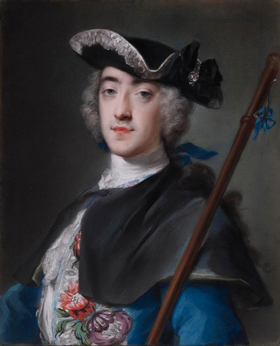2.28.24 — The Company He Keeps
The man I knew only as a pilgrim has abandoned his pilgrimage. His portraitist, Rosalba Carriera, could have seen it coming—but not his place with Nicolas Party at the Frick Madison, through March 3. I also work this together with an earlier report on the wealth of “Tudor England” at the Met as a longer review and my latest upload.
Carriera entered the Frick Collection just this past year, with the Gregory gift, and her Man in Pilgrim’s Costume leaves a dark gray spot on the wall. Its companion, a female portrait,  remains behind through the midsummer end of the gift’s display. So, too, does their shared spirit of Rococo excess. He might have claimed his luxurious surroundings, amid the decorative arts, as his own. He could also have scorned them, with pleasure, as impious and inferior—or was that just a pose? Scholars speculate that his costume merely alludes to his family name.
remains behind through the midsummer end of the gift’s display. So, too, does their shared spirit of Rococo excess. He might have claimed his luxurious surroundings, amid the decorative arts, as his own. He could also have scorned them, with pleasure, as impious and inferior—or was that just a pose? Scholars speculate that his costume merely alludes to his family name.
Perhaps, but art has a long tradition of titled wealth putting on airs of piety and humility. How better for the Tudor court in England to show its place among kings? How better for Pietro Aretino at the Frick, the author of lives of saints along with satires, to display his dignity. knighthood, and erudition, in a portrait by Titian. As I wrote about the gift, the man wields his pilgrim’s staff like a weapon. His identity remains unknown, but then Carriera could not pull off psychology or particulars. No wonder she appealed to collectors of ceramics, gilding, and privilege.
Is the pretend pilgrim also just plain silly? Party embraces silliness. His is the second pairing of historic work from the collection with contemporary art. The series began after the move to the former Whitney Museum and Met Breuer on Madison Avenue while the Frick mansion is closed for renovation. Dubious about the shift in great museums like the Met, the Morgan Library, and now the Frick to indulge in contemporary art? Party could well be satirizing it. He can also do a pretty good imitation of the old masters, give or take bright purple.
Carriera gives pastels the richness of portraits in oil, and Party does her one better. Born in Switzerland in 1980, he uses an alcove in a room for Renaissance portraits to give her portrait both its forebears and a place to itself. It hangs between facing waist-up portraits in the same high style. One has white hair, in accord with eighteenth-century fashion but as bushy as an afro. The other has black hair but flecked with white, to match the white spots of its outrageous clothing. The one with white hair is young and white, the one with black hair, sure enough, a bright purple.
They also have red lips and uncertain gender, like so much art today. (Your guess is as good as mine.) Their fancy dress approaches the decorative arts after all, but not nearly as much as the walls behind them. Party’s pastels extend to them. They blow up Carriera’s fluid touch to wallpaper. They also carry her realism to the illusion of fabric.
The wall behind her painting pictures folds upon folds of fabric, leaving the underlying folds and fringes in shadow. The one behind the purple person billows out, while the one behind the white person blurs away. Oh, and the latter wears a purple shirt and red tie to match its companion’s purple face and red-flecked top. Does all this pretence and patterning upstage a mere pilgrim? Maybe he would have said that he deserves the company. Or maybe he would have said that it shows his superiority and his piety.
Read more, now in a feature-length article on this site.